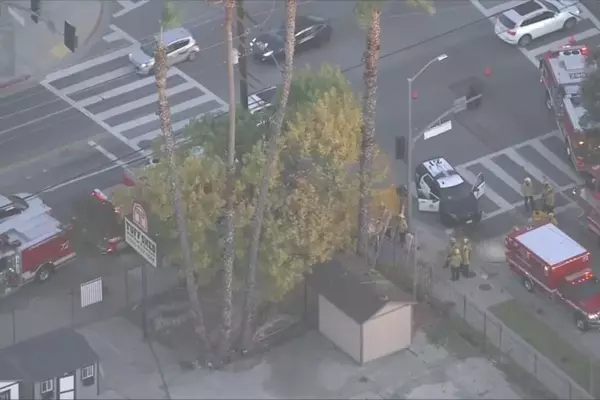
On foggy, freezing mornings for the past two and half months, members of the public have queued outside the Latrobe Valley law courts, hoping to catch a glimpse of proceedings in courtroom four.
The murder trial of Erin Patterson and her beef wellingtons laced with death cap mushrooms has gripped the imagination of the public. Media in Australia and around the world has focused its lens on Morwell in Victoria’s Gippsland region, which has embraced the attention. One local cafe even served mushroom soup throughout the proceedings.
It’s far from the first time a small Australian town has found itself at the heart of a crime that has captured the world’s attention. But what happens when the media circus moves on?
On Monday, when a jury found Patterson guilty of murdering three relatives and attempting to murder a fourth, Det Insp Dean Thomas of the Victoria police homicide squad urged people not to forget the victims of the crime. At times, it has almost been lost amid the frenzy that three people died – Gail and Don Patterson and Heather Wilkinson – and a fourth, Ian Wilkinson, only just survived after falling into an induced coma, all after attending a family lunch.
Public interest in disturbing crimes is not new, says Prof Lisa Waller, the associate dean of communication at RMIT, but the Patterson case may be “the first really intense Australian example of it”.
Sometimes, heightened public attention can develop into “dark tourism” – travel specifically to places historically associated with death, tragedy or the macabre, and, often, commercial ventures set up to profit from it.
Will Morwell, where the Patterson trial was held, or Leongatha, where Patterson lived and served the fatal lunch, be next? And would that be fair to the family, who have requested privacy, and the people for whom these towns are home?
The fascination with justice occurring in the public eye “harks back to that almost medieval idea about crime and punishment being a very public thing”, Waller says.
“People aren’t thinking that they’re part of the mob, out in the town square, looking at the person that’s about to be burned at the stake or put into the stocks or whatever,” she says. “But at some really kind of elemental level … it’s powerful.”
Overseas, dark tourism is a thriving industry: some of the best-known sites include the Nazi death camp Auschwitz-Birkenau in Poland, the ruins of Pompeii in Italy, Chornobyl in Ukraine, Ground Zero in New York City and the Paris Catacombs. In Japan, the dense and haunting Aokigahara Forest is notorious for its association with suicides. In London, there’s Tower Green, where Anne Boleyn was executed, and in Washington DC, Ford’s Theatre, where Abraham Lincoln was assassinated.
More than a century ago, the state of Victoria was transfixed by another figure: Frederick Deeming, later dubbed the “Jack the Ripper of Australia”. After murdering his wife and burying her beneath a hearthstone in a Windsor home, he was tried and executed in a case that captured headlines around the world. These days, the Deeming case is the subject of a tour that winds through Melbourne to the sites of his crimes. It’s not the only “true crime” tour of its kind; the company that runs it also offers true crime tours in Adelaide, Brisbane, Fremantle, Fortitude Valley, Maitland, Newcastle and Perth.
Associate Prof Jenny Wise from the University of New England says the fascination with the sites and ephemera associated with grisly crime is thought to come partly from society moving away from embracing death as an everyday part of life. “We are seeking other ways to try to engage with death and to experience death, but in that safe way,” she says.
“Unfortunately, it’s usually the sites where the most atrocious things have occurred [that dark tourism develops] … those really gory or sensational crimes that have almost become urban legends,” Wise says.
The economic benefit to Morwell from the influx of journalists, podcasters, screenwriters and photographers has been considerable: Latrobe city council has spruiked the “strong increase in external visitor spending”, noting that in Traralgon, the biggest town in the region and where most visitors find a place to stay, external visitor local spend grew to $20.13m in the month of May 2025, a $2.56m increase on the previous year. In Morwell, home of Latrobe Valley courts, there was an increase from $5.88m in 2024 to $6.21m in 2025.
“The uplift in spend may also be partially attributed to increased foot traffic in the Morwell CBD associated with legal proceedings at the Latrobe Valley law court,” a council spokesperson said.
But about 60km away, in Leongatha, as the jury’s deliberations began, the town closed ranks. Black plastic tarps were put up around Patterson’s home. Another 15km north, at the Korumburra Baptist church – where the lunch survivor, Ian Wilkinson, is pastor – journalists’ questions were left unanswered. Signs have been posted outside the homes of the Wilkinsons, Patterson’s estranged husband, Simon, and her sister, Ceinwen Scutter, pleading for privacy and warning journalists not to trespass.
Wise says whether or not dark tourism industries are successful “really depends on the community at the time, the type of crime, but also the vendors that are providing these opportunities and how willing they are to weather the storm”. She notes how guided ghost tours of the New South Wales forest where serial killer Ivan Milat buried his victims were swiftly cancelled after public backlash.
“The victims want their privacy, and I think that’s a really important aspect of it. There are ways to be interested in these kind of cases while still being ethical about it, and that’s really obviously very important,” Wise says.
Waller’s research has examined the media reporting of crime in small towns, such as Moe, where toddler Jaidyn Leskie died in 1997, and Snowtown, where bodies of murder victims were found in barrels in a bank vault. She says it can take a very long time for a community to rehabilitate after experiences like that, especially when their town’s name becomes a byword for the crime itself.
“When the big media come to town, people feel exposed, and that somehow the crime is a spectacle, and that casts a bit of a shadow over everyone.”







